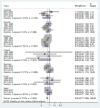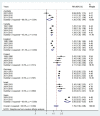Gender differences in tuberculosis incidence rates-A pooled analysis of data from seven high-income countries by age group and time period
- PMID: 36703824
- PMCID: PMC9873377
- DOI: 10.3389/fpubh.2022.997025
Gender differences in tuberculosis incidence rates-A pooled analysis of data from seven high-income countries by age group and time period
Erratum in
-
Corrigendum: Gender differences in tuberculosis incidence rates-A pooled analysis of data from seven high-income countries by age group and time period.Front Public Health. 2023 Feb 21;11:1157235. doi: 10.3389/fpubh.2023.1157235. eCollection 2023. Front Public Health. 2023. PMID: 36895682 Free PMC article.
Abstract
Introduction: Gender differences in the incidence rates for tuberculosis are occasionally reported. However, the magnitude and consistency of the differences by age group, among different populations, and over extended periods of time are not clear.
Materials and methods: We obtained national data from seven countries from open-access internet sites or personal communications with official representatives. We computed the male-to-female incidence rate ratios (IRRs) by country and year for every age group and pooled these ratios using meta-analytic methods. Meta-regression analysis was performed to estimate the contribution of age, country, and calendar years to the variation in the IRRs.
Results: In the age groups of < 1, 1-4, 5-9, and 10-14, the pooled male-to-female IRRs (with 95% CI) were as follows: 1.21 (1.05, 1.40), 0.99 (0.95, 1.04), 1.01 (0.96, 1.06), and 0.83 (0.77, 0.89), respectively. In the age groups 15-44, 45-64, and 65+ years, incidence rates were significantly higher in men, with IRRs of 1.25 (1.16, 1.35), 1.79 (1.56, 2.06), and 1.81 (1.66, 1.96), respectively. Meta-regression analysis revealed that age significantly contributed to the variation in the IRRs.
Conclusions: There were gender differences in the incidence rates for tuberculosis, with higher rates in boys aged less than one, no significant differences in boys of ages 1-9, and higher rates in boys/men older than 15. The only excess in female gender was in the age group 10-14 years. The age-related gender differences in tuberculosis incidence rates observed over several countries indicate the importance of including sex as a biological variable when assessing the risk factors for tuberculosis.
Keywords: gender; incidence rate ratio; male-to-female; meta-analysis; meta-regression; sex differences; tuberculosis.
Copyright © 2023 Peer, Schwartz and Green.
Conflict of interest statement
The authors declare that the research was conducted in the absence of any commercial or financial relationships that could be construed as a potential conflict of interest.
Figures







Similar articles
-
Gender differences in measles incidence rates in a multi-year, pooled analysis, based on national data from seven high income countries.BMC Infect Dis. 2022 Apr 11;22(1):358. doi: 10.1186/s12879-022-07340-3. BMC Infect Dis. 2022. PMID: 35410143 Free PMC article.
-
A meta-analytic evaluation of sex differences in meningococcal disease incidence rates in 10 countries.Epidemiol Infect. 2020 Oct 2;148:e246. doi: 10.1017/S0950268820002356. Epidemiol Infect. 2020. PMID: 33004098 Free PMC article.
-
Sex differences in campylobacteriosis incidence rates at different ages - a seven country, multi-year, meta-analysis. A potential mechanism for the infection.BMC Infect Dis. 2020 Aug 25;20(1):625. doi: 10.1186/s12879-020-05351-6. BMC Infect Dis. 2020. PMID: 32842973 Free PMC article.
-
[SENTIERI - Epidemiological Study of Residents in National Priority Contaminated Sites. Sixth Report].Epidemiol Prev. 2023 Jan-Apr;47(1-2 Suppl 1):1-286. doi: 10.19191/EP23.1-2-S1.003. Epidemiol Prev. 2023. PMID: 36825373 Italian.
-
Prevention of suicide and attempted suicide in Denmark. Epidemiological studies of suicide and intervention studies in selected risk groups.Dan Med Bull. 2007 Nov;54(4):306-69. Dan Med Bull. 2007. PMID: 18208680 Review.
Cited by
-
Factors associated with successful treatment outcomes among tuberculosis patients in a district municipality of Vhembe, Limpopo.S Afr Fam Pract (2004). 2025 Jan 31;67(1):e1-e7. doi: 10.4102/safp.v67i1.6030. S Afr Fam Pract (2004). 2025. PMID: 39935156 Free PMC article.
-
Analysis of the epidemiological characteristics of pulmonary tuberculosis in Shijiazhuang, China 2010-2023.Front Public Health. 2025 Jul 3;13:1621695. doi: 10.3389/fpubh.2025.1621695. eCollection 2025. Front Public Health. 2025. PMID: 40678650 Free PMC article.
-
Uncovering the burden of tuberculosis in Algeria: a retrospective analysis from 2019 to 2024.Antonie Van Leeuwenhoek. 2025 May 23;118(6):80. doi: 10.1007/s10482-025-02096-7. Antonie Van Leeuwenhoek. 2025. PMID: 40407944
-
Impact of the Stool-Based Xpert Test on Childhood Tuberculosis Diagnosis in Selected States in Nigeria.Trop Med Infect Dis. 2024 May 1;9(5):100. doi: 10.3390/tropicalmed9050100. Trop Med Infect Dis. 2024. PMID: 38787033 Free PMC article.
-
A High Burden of Infectious Tuberculosis Cases Among Older Children and Young Adolescents of the Female Gender in Ethiopia.Trop Med Infect Dis. 2025 Mar 17;10(3):79. doi: 10.3390/tropicalmed10030079. Trop Med Infect Dis. 2025. PMID: 40137832 Free PMC article.
References
-
- World Health Organization . Global Tuberculosis Report 2020. Geneva: World Health Organization; (2020).
-
- Bai GH, Kim SJ, Lee EK, Lew WJ. Incidence of pulmonary tuberculosis in Korean civil servants: second study, 1992–1994. Int J Tuberc Lung Dis. (2001) 5:346–53. - PubMed
-
- WHO . Global Tuberculosis Report 2017. (2017). Geneva: World Health Organization.
-
- Chan-Yeung M, Noertjojo K, Chan SL, Tam CM. Sex differences in tuberculosis in Hong Kong. Int J Tuberc Lung Dis. (2002) 6:11–8. - PubMed
Publication types
MeSH terms
LinkOut - more resources
Full Text Sources
Medical

